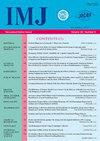MECHANISMS AND FEATURES OF IMMUNE STATUS AND "OXIDATIVE STRESS - ANTIOXIDANT PROTECTION" SYSTEM IN PATIENTS WITH TUBERCULOSIS
Q4 Medicine
引用次数: 0
Abstract
The study of the human immune system state in infection with M. tuberculosis is relevant because the course and outcome of this disease are largely determined by the immune status of the patient. However, 98 % of patients with pulmonary tuberculosis have an immune imbalance. It is known that in the protection against tuberculosis an important role belongs to the body's natural resistance, which is provided by a variety of cellular and humoral factors, physicochemical characteristics of tissues, lymphoid cells, leukocyte and macrophage responses and genetic resistance. When mycobacteria enter the body, polymorphonuclear leukocytes, monocytes and macrophages are the main phagocytic cells. Optimally high level of resistance to the pathogen develops only in the coordinated interaction of T−lymphocytes with macrophages. Studies of cellular immunity and genetic markers have shown that the course of tuberculosis infection is associated with suppression of their functional activity. Immune response deregulation is closely related to oxidative stress, which results from an imbalance between free reactive oxygen species and antioxidant mechanisms, with a higher risk of developing it rather in lungs than other organs. Many studies have presented the results of studying the state of the immune system and the "oxidative stress − antioxidant protection" system in tuberculosis. This is an important component, because the clinical course and outcome of treatment is largely determined by the status of these systems. A number of experts point out that the study of immunological and oxidative parameters in tuberculosis is of a great importance for deciding on the tactics of treatment and the choice of direction of influence on the course of the disease. Key words: M. Tuberculosis, immunity in tuberculosis, oxidative stress, antioxidant protection.结核病患者免疫状态及“氧化应激-抗氧化保护”系统的机制和特点
对感染结核分枝杆菌的人类免疫系统状态的研究是相关的,因为这种疾病的病程和结果在很大程度上取决于患者的免疫状态。然而,98%的肺结核患者存在免疫失衡。众所周知,在预防结核病方面,一个重要的作用属于身体的自然抵抗力,它是由多种细胞和体液因素、组织的物理化学特性、淋巴细胞、白细胞和巨噬细胞反应以及遗传抵抗力提供的。分枝杆菌进入体内时,多形核白细胞、单核细胞和巨噬细胞是主要的吞噬细胞。对病原体的最佳高水平耐药性仅在T淋巴细胞与巨噬细胞的协调相互作用中产生。对细胞免疫和遗传标记的研究表明,结核病感染的过程与其功能活性的抑制有关。免疫反应失调与氧化应激密切相关,氧化应激是由游离活性氧和抗氧化机制之间的失衡引起的,在肺部而不是其他器官中发生这种情况的风险更高。许多研究都提出了研究结核病免疫系统和“氧化应激-抗氧化保护”系统状态的结果。这是一个重要的组成部分,因为临床过程和治疗结果在很大程度上取决于这些系统的状态。许多专家指出,研究结核病的免疫和氧化参数对于决定治疗策略和影响病程的方向具有重要意义。关键词:结核分枝杆菌,结核病免疫,氧化应激,抗氧化保护。
本文章由计算机程序翻译,如有差异,请以英文原文为准。
求助全文
约1分钟内获得全文
求助全文
来源期刊

International Medical Journal
医学-医学:内科
自引率
0.00%
发文量
21
审稿时长
4-8 weeks
期刊介绍:
The International Medical Journal is intended to provide a multidisciplinary forum for the exchange of ideas and information among professionals concerned with medicine and related disciplines in the world. It is recognized that many other disciplines have an important contribution to make in furthering knowledge of the physical life and mental life and the Editors welcome relevant contributions from them.
The Editors and Publishers wish to encourage a dialogue among the experts from different countries whose diverse cultures afford interesting and challenging alternatives to existing theories and practices. Priority will therefore be given to articles which are oriented to an international perspective. The journal will publish reviews of high quality on contemporary issues, significant clinical studies, and conceptual contributions, as well as serve in the rapid dissemination of important and relevant research findings.
The International Medical Journal (IMJ) was first established in 1994.
 求助内容:
求助内容: 应助结果提醒方式:
应助结果提醒方式:


